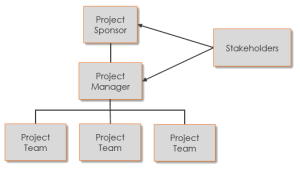
Obviously projects span a huge spectrum from big to small, innovative to routine, and technical to repetitive. But there is in fact a standard project organization chart within which all projects fall. The project management model within the PMBOK, as well as other project management methodologies, define this standard structure.
The project management organization chart looks like this:
Project Sponsor
This is the person to whom the project’s deliverables are delivered. They are one level above the project manager. They are not directly involved with the project’s day to day execution, but they usually have some form of responsibility for the success and/or failure of the project. They often have a say in major project decisions and have an ongoing awareness of the project’s status.
For example, a project to build a bridge is likely to have a project manager within the construction company, and a project sponsor within the owner organization (eg. government). The project sponsor is not responsible for the day to day operations of the project, but is the funding liaison and central organizational contact for the project.
Often the project sponsor was in a “project champion” role before the project was initiated, making presentations and drumming up support for the project.
They can be internal or external to the organization carrying out the project. A common organizational structure is to have the project sponsor as part of an “owner” organization, such as an oil company, and the project manager and project team within a “consultant” organization, like an engineering firm.
Project Manager
The project manager is the person that handles the day to day administration of the project and project team and is ultimately accountable for the project’s success. Their job is to ensure the project deliverables are produced on time, on budget, on quality, and with all stakeholders are satisfied.
They can be from the same organization or a different one, as is often the case with a vendor organization that was contracted to produce a set of deliverables.
The project manager produces the project plan and then ensures the project stays within the plan. This plan takes the form of a document called a Project Management Plan. The project sponsor approves the project management plan during the planning phase and it then becomes the official reference for the project. If changes need to be made, the project manager generally requests changes from the project sponsor, especially if there is time or more money involved.
Sometimes the project is managed by a team, particularly on large industrial or oilfield projects. In this case there must a lead project manager, and the other project managers produce the project management documents such as schedules, estimates, quality criteria, risk analyses, and so forth.
Project Team
This group carries out the project work. They produce the project’s deliverables and perform the tasks necessary to finish the project. Although they are normally in a position to take responsibility for their work, it is project manager who ultimately must take responsibility for the success or failure of the project.
Project team members can come from other departments or they can be hired externally. If any members of the project team have ongoing commitments to their departments, it is even more imperative to manage their work to ensure the project does not suffer. This is done via a resource calendar.
 Stakeholders
Stakeholders
Every project, by definition, has someone who has an interest in its outcome. As a minimum the project sponsor could be considered a stakeholder because they are expecting the deliverables at a certain time, budget, and quality level. Only very small projects have no other stakeholders, for example pouring concrete on your sidewalk you might not have anyone else to please but yourself. But much bigger than that and there will undoubtedly be other stakeholders who need to be kept informed and actively managed.
It is the project manager’s job to know all the stakeholders, no matter how insignificant they are, and ensure their approval is earned. Some stakeholders are supporters, such as local business groups for a new stadium. Some are opposed, like environmental groups, and some simply wish to keep informed of the status, like city building permit officials. Their position can, of course, change if their needs are not met by the project manager.
Stakeholders come in many forms:
- Clients, customers, and end users. These are the ultimate purchasers of the products or services which the project produces. Often these don’t formally exist because the project sponsor can serve exclusively in this role. If they do, however, they will indirectly dictate project criteria like quality standards, budgets, and grade (or specs and feature lists). Often the project needs to incorporate market testing or other customer response surveys which make them a core part of the project.
- Investors. Often the project contains investors who have a financial stake in the success of the project, and the project manager must keep them informed of the status of the project.
- Vendors. Many projects outsource project work to other firms. These firms require active management by the procuring organization to ensure the quality level, timeliness, and budgets are kept within expectations.
- Organizational Groups. Many projects affect other areas of the organization. Functional managers lend project staff, safety coordinators have their hand in the day to day work, financial people want interim updates, and the list goes on.
- Regulatory Agencies. Most projects have government regulations that affect their work, and this can have a substantial impact to the project, either cost, time, or both.
- Major Stakeholders. Sometimes there is one stakeholder who has an enormous stake in the project outcome, and requires a tremendous amount of time and effort to keep satisfied. For example in a school building project, the plumbing contractor has the general contractor as a major stakeholder.
Project Organization Chart within the Project Management Plan
The Project Management Body of Knowledge (PMBOK) requires that the project sponsor, project manager, and stakeholders be identified within the project management plan. The project team members are optional but usually a good idea as well.
This should take place near the beginning of the document and its format is very simple. It should be a bulleted or tabled list of all the project members, including full contact information so that the project management plan can serve as the central project reference. A graphical organization chart looks great but is not necessary.







